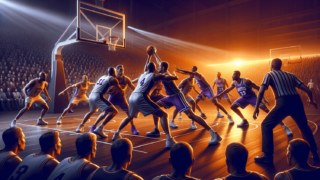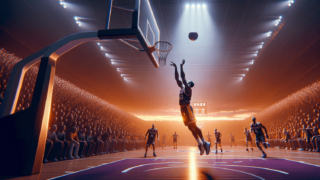
If you’ve ever found yourself watching a basketball game and suddenly everyone starts yelling about a “backcourt violation” with no clue as to what just happened, then you’re in the right place! This blog post aims to demystify this exciting and often misunderstood aspect of basketball. A backcourt violation occurs when a player of the team possessing the ball crosses back into their own half of the court after advancing the ball past midcourt. Read on to explore the intricacies of backcourt violations, their implications on the game, and how these rules have evolved to shape the fast-paced sport we all love.
What’s a Backcourt Violation in Basketball?
A backcourt violation in basketball is an infraction that occurs when the team with possession of the ball crosses back into their own half of the court after advancing the ball past midcourt. This rule encourages continuous forward progress and helps maintain the fast pace of the game. A backcourt violation results in a turnover, giving possession of the ball to the opposing team.
The Fundamentals of Backcourt Violations: A Step-by-Step Breakdown
Understanding the intricacies of a backcourt violation involves familiarizing ourselves with key terms and concepts as they apply to this aspect of basketball. Let’s examine the fundamental principles governing a backcourt violation step-by-step.
1. The Midcourt Line and Court Divisions
A basketball court is divided into two equal halves separated by a midcourt line. Each half is allocated to one of the teams, with the half containing the team’s basket being referred to as their frontcourt, while the other half is called their backcourt. A team’s goal is to move the ball from their backcourt to their frontcourt, where they attempt to score.
2. Establishing Offensive and Defensive Positions
Once the ball is in play, the team with possession becomes the offensive team, while the other team is considered the defensive team. It is the responsibility of the offensive team to bring the ball from their backcourt into their frontcourt within a fixed timeframe to create scoring opportunities. Due to the defensive team’s efforts to prevent scoring, the offensive team must employ strategies and tactics to progress the ball forward and maintain possession.
3. The Backcourt Violation Rule
A backcourt violation occurs when a player on the offensive team—after the ball has been advanced into the frontcourt—either directly or indirectly causes the ball to return to their backcourt without first being touched by a player on the defensive team. This violation is in place to maintain the flow of the game and promotes continuous forward progress.
Key Components of a Backcourt Violation
Now that we understand the basics, we can delve into the crucial elements of a backcourt violation. There are three primary factors that determine whether a backcourt violation has occurred: control, plane, and touch.
1. Control of the Ball
A backcourt violation can only be called if the offensive team is in control of the ball, meaning a player must possess, hold, or manage the ball’s movement. Bouncing, dribbling, or passing the ball are all considered acts of control. However, if the ball is loose or in the air, no backcourt violations can be called.
2. The Plane of the Midcourt Line
A player, while in control of the ball, must be considered to have completely crossed the midcourt line, in which both feet and the ball must be entirely within the frontcourt for a backcourt violation to occur. Notably, the midcourt line changes from an invisible barrier to an actual plane once the player has crossed. This vertical plane extends from the court’s surface to the ceiling, and any contact with it by the ball under the offensive team’s control results in a backcourt violation.
3. Touching the Ball
If a player from the offensive team accidentally or intentionally touches the ball after crossing into the frontcourt, and the ball subsequently goes into the backcourt, a backcourt violation is called. An exception to this rule is if the defensive team makes contact with the ball or alters its path, in which case, the offensive team can freely retrieve the ball in their backcourt without committing a violation.
Type of Backcourt Violations
There are unique scenarios in which backcourt violations occur. Gaining a deeper understanding of these situations will provide players, coaches, and fans with more insight into the game of basketball.
1. Dribbling Over-and-Back
A common backcourt violation involves a player who dribbles the ball across the midcourt line and then inadvertently dribbles the ball back into their backcourt. This often transpires when a player loses control of the ball or tries to avoid a defender.
2. Passing Over-and-Back
A player who passes the ball to a teammate in the backcourt after establishing themselves and the ball in the frontcourt is also guilty of a backcourt violation. These scenarios typically arise when a player misreads their teammate’s movements, leading to a poorly executed pass.
3. Forced Over-and-Back
In some cases, an alert defender can bait an offensive player into committing a backcourt violation. If the defender disrupts the dribble, the ball handler might lose control of the ball, leading to an unintentional dribble or pass back into their backcourt.
Key Rules and Exceptions in Backcourt Violations
While the basic outline of backcourt violation rules has been established, there are additional nuances and exceptions to be aware of to fully comprehend this aspect of basketball.
1. Time Limit for Crossing Half Court
In most leagues, an offensive team is given a specific amount of time to advance the ball past the midcourt line. In the NBA, this time limit is eight seconds, while FIBA and NCAA leagues grant ten seconds. Failure to advance the ball within this timeframe results in a turnover, which is technically unrelated to backcourt violations but similarly punishes teams for not progressing their attack efficiently.
2. Rules for Comparison: NBA, NCAA, and FIBA
While the basic principles of backcourt violations are consistent across all basketball organizations, there are some slight differences amongst the NBA, NCAA, and FIBA rules. These disparities are primarily related to the timeframe to advance the ball and specific situations where a backcourt violation is enforced or exempted.
3. Over-and-Back After a Deflection or Steal Attempt
If a player from the defensive team actively reaches for the ball, deflects it, or attempts to steal it, and the ball returns to the backcourt, it is not considered a backcourt violation. Instead, the offensive team is allowed to retrieve the ball and continue playing without any penalty.
4. Alternating Possession and Free Throws
During an alternating possession or a free throw situation, the offensive team has not yet passed the midcourt line once the ball is inbounded. Therefore, they cannot be penalized for a backcourt violation until they establish themselves in the frontcourt.
5. Inbounding the Ball from the Frontcourt
If a player inbounds the ball from their frontcourt and it directly hits the midcourt line before making contact with any other player, a backcourt violation is enforced. This highlights the importance of mindful passing during the inbound process.
Understanding Backcourt Violations and Strategy
Developing a comprehensive knowledge of backcourt violations can lead to better decision-making on the court and a deeper appreciation for the game. Both players and coaches can use this information to develop effective offensive and defensive strategies.
1. Exploiting Defenses Using Backdoor Cuts
A team that fully understands backcourt rules can exploit weak defenses, open up space for backdoor cuts or pressure releases, and reduce the likelihood of a violation. While backdoor cuts are not directly related to backcourt violations, a deeper understanding of the game’s intricacies creates options for creative offensive plays.
2. Press Defense and Transition Offense
For the defensive team, applying full-court or half-court press can force the opposing team into making hasty decisions, triggering backcourt violations or other turnovers. Aggressive press defenses and a well-coordinated transition offense can help take advantage of the opponent’s vulnerability in these situations.
3. Communication and Ball Handling Skills
Players with excellent communication and ball handling skills are less likely to commit backcourt violations. Through diligent practice, players can improve their dribbling, passing, and decision-making abilities, resulting in a more successful offensive unit.
Armed with this extensive understanding of backcourt violations, you’re now equipped to engage more deeply in the game of basketball, whether as a player, coach, or spectator. Keep these principles in mind as you enjoy the sport, and you’ll soon be seeing the game through a new lens.
Preventing and Exploiting Backcourt Violations: Tips and Strategies
In addition to understanding the fundamentals and rules of backcourt violations, becoming proficient in the strategies related to preventing and exploiting backcourt violations can greatly enhance your performance on the court. Implementing these tips can create a more cohesive team, promote better decision-making, and mitigate the risk of losing possession due to unnecessary turnovers.
1. Improve Court Awareness
Players must develop a keen sense of court awareness to anticipate potential backcourt violation situations. Increasing spatial awareness of the midcourt line, teammates’ positions, and the defensive team’s movements can contribute to more accurate passes and better dribbling decisions, reducing the likelihood of committing a violation.
2. Execute Smart, Controlled Passes
One of the primary causes of backcourt violations is poorly executed or misread passes. To prevent these mistakes, players must practice making controlled, precise passes that safely reach their intended teammate. A conscious effort to deliver the ball in a manner that prevents it from inadvertently crossing back into the backcourt will significantly reduce violation risks.
3. Use Fakes and Misdirection
By incorporating fakes and misdirection into your offensive repertoire, you can exploit aggressive defenses that attempt to force backcourt violations or turnovers. This tactic may involve employing quick change-of-pace dribbles or employing deceptive passing techniques to keep defenders guessing, thereby creating more opportunities to advance the ball and reduce backcourt violation risks.
4. Keep Calm Under Pressure
It is crucial for players to remain calm and composed under pressure from defenders, as panic often leads to poor decisions and inadvertent backcourt violations. Developing coping mechanisms for stress, such as focused breathing or positive self-talk, can help players maintain control of their actions on the court and reduce the chance of critical errors.
5. Study Opposing Teams’ Tendencies
By analyzing the tendencies and strategizing habits of opposing teams, players and coaches can exploit weaknesses and anticipate potential traps that might lead to backcourt violations. For instance, identifying a defender’s tendency to overcommit enables the offensive player to cut back and exploit any space created as a result of the defender’s aggression.
Implementing these strategies can help you master the art of managing backcourt violations and contribute to a more successful game experience. Recognize that practice, study, and communication will ultimately propel you and your team to greater heights in the dynamic world of basketball competition.
Frequently Asked Questions About Backcourt Violations
Whether you’re new to basketball or a seasoned fan, backcourt violations can raise several questions regarding scenarios, exceptions, and the impact of these violations on the game. In this FAQ section, we answer some of the most common questions related to backcourt violations and provide insightful, NLP-style responses to improve your understanding of this game concept.
1. What happens as a result of a backcourt violation?
When a backcourt violation is called, the team committing the violation turns the ball over, and the opposing team takes possession of the ball from the sideline nearest to where the violation took place.
2. Are backcourt violations called during a jump ball situation?
No, backcourt violations are not called during a jump ball scenario. The team that gains possession of the ball from a jump ball is not yet in control of the ball in their frontcourt, so they cannot be penalized for a backcourt violation at that time.
3. Can a backcourt violation occur during an inbounds play?
Yes, a backcourt violation can occur during an inbounds play if the inbounder throws the ball to a teammate who has both feet and the ball entirely within the frontcourt, and then the ball subsequently enters the backcourt.
4. Can the defensive team cause a backcourt violation?
No, only the offensive team can commit a backcourt violation. The defensive team can, however, contribute to creating situations where the offensive team is more likely to commit a backcourt violation by applying pressure or attempting to deflect passes.
5. Is it a backcourt violation if the ball lands directly on the midcourt line?
Yes, if the ball lands directly on the midcourt line after the offensive team has completed crossing into their frontcourt, it is considered a backcourt violation.
6. Can a backcourt violation happen during a free throw?
No, backcourt violations cannot occur during free throw attempts. Free throws are not affected by backcourt violation rules as the offensive team is already situated in the frontcourt.
7. What is the time limit for crossing half court?
In the NBA, the offensive team has 8 seconds to advance the ball past the midcourt line, while NCAA and FIBA leagues have a 10-second restriction. Failure to cross within the allotted time results in a turnover, independent of backcourt violation rules.
8. Does the shot clock reset after a backcourt violation?
Yes, the shot clock resets after a backcourt violation to give the team taking possession of the ball a new opportunity to create scoring chances.
9. How does a player avoid committing a backcourt violation when pressured by a full-court press?
To avoid committing a backcourt violation under full-court pressure, players should stay calm, use fakes and change-of-pace dribbles, make smart passes, communicate effectively, and envision the midcourt line’s location to decrease error likelihood.
10. Can a backcourt violation occur during an alternating possession scenario?
No, backcourt violations cannot occur during an alternating possession scenario. Similar to jump ball situations, the team that gains possession of the ball from an alternating possession is not yet in control of the ball in their frontcourt, so they cannot be penalized for a violation.
Featured Posts
- No pillar pages found.





